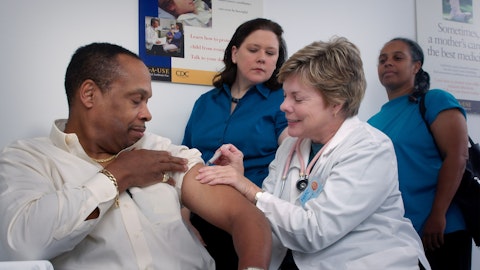Stephen Hoge: Correct. They’re immunogenicity and safety studies. So very quick studies, just demonstrating – we do not believe nor is it the norm from a regulatory perspective that you have to do subsequent efficacy studies once you’ve established the efficacy of the monovalent vaccine.
Operator: Our next question comes from Manos Papadakis with Deutsche Bank.
Emmanuel Papadakis: Basically, I just wanted to ask in terms of the COGS guidance, does that apply regardless of the revenue range? And if not, what is the sensitivity range that you could provide?
Jamey Mock: Yes, it does apply regardless, as I mentioned in my prepared remarks. Most of this cost is fixed at this point. We’ve already ordered the raw materials. We’ve already started manufacturing most of our – we’ve got a lot of supply ready to go as soon as we are able to – as soon as we’ve got regulatory approval. So that $3.5 billion to $4 billion is not really dependent too much on the sales outcome that will happen either way. And maybe just to talk to longer term, so I think what we’re suffering with this year is just an unpredictable market. So back to the prior question of the 35% to 40% or 60% to 65% gross margin, as it becomes more predictable, we will be able to order the right amount of material, have the right amount of volume commitments, that might not happen in 2024 as we work through some of our commitments. But we feel very confident in the overall 75% to 80% gross margin range in the long term.
Operator: Our next question comes from Geoff Meacham with Bank of America.
Alexandria Hammond: This is Alex on for Geoff. Can you talk about all the other potential indications you may pursue for the INT vaccine? And how will you decide which indications to pursue first? Will this be based on [indiscernible] or an unmet need? Secondly, what commercial hurdles do you expect for flu and RSV, given the entrenched competition and new entrants respectively?
Stephen Hoge: First on INT, so obviously, we’re moving forward in melanoma, as you know. And we’re moving forward in non-small cell lung cancer. I think the opportunity there is – the unmet need there is obviously very significant. And as we know, that’s one of the largest opportunity for immune therapies generally, and so it’s an obvious place for us to go next. As we’ve said before, we have not yet publicly guided with our partner, Merck, on what the other indications will be. But we have said that we are going to follow the path of all the places where PD-1 Keytruda have been successful, but where we think there is still headroom, still opportunity to significantly improve upon what’s been achieved with the PD-1 antibodies.
And so, you can follow through the adjuvant settings as well as perhaps some of the stage 4 settings, where there are those benefits and expect us to be moving there in short order. Ourselves and Merck are in the process of finalizing some of those plans. And at the appropriate time, obviously, we’ll guide you on the start of those studies. But rest assured, as we’ve said and as they said before, there is a quite large program of studies that will be ramping up here in very short order, and melanoma and non-small cell lung cancer are really just the first two.
Arpa Garay: And I can take the question on RSV and flu, we are very excited to be launching RSV next year. So while we will be bringing the third product to market, we’re very confident in what we believe is a best-in-class profile with our consistently high effectiveness across high-risk groups, thinking about our well-established safety profile in the only mRNA platform for RSV, and lastly, as I mentioned earlier, being the only product with a ready-to-use prefilled syringe. So we’re feeling really good about the RSV launch preparations, and we’re ready to execute in 2024. From a flu perspective, we do think one of the advantages of 1010, which would be our first-generation flu vaccine, is our speed to market could give us an opportunity for better strain matching in the future.




